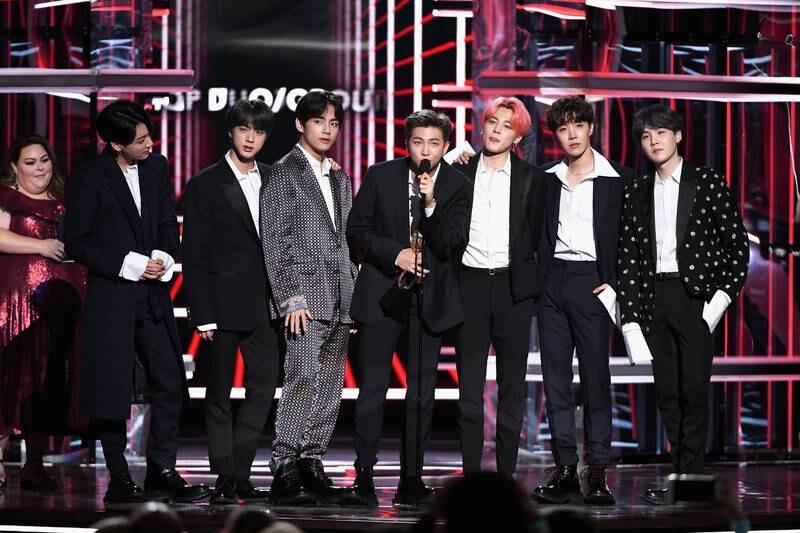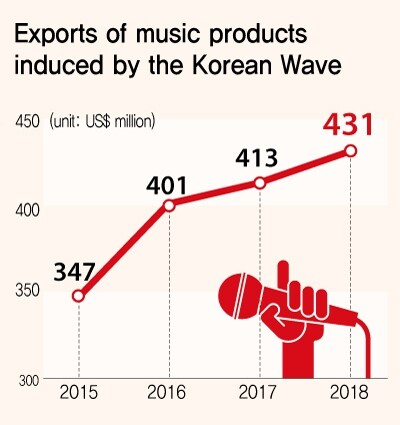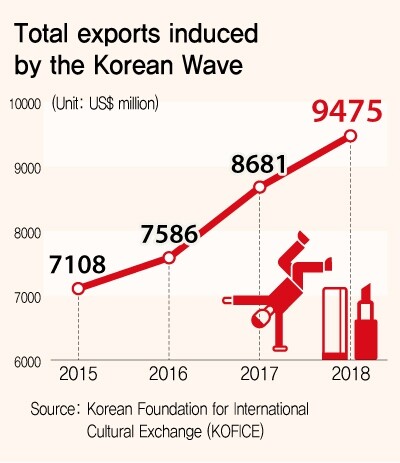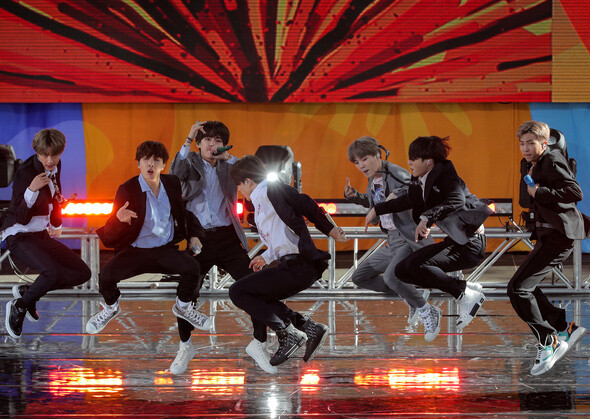hankyoreh
Links to other country sites 다른 나라 사이트 링크
[News analysis] Analyzing K-pop’s explosion onto the global stage

Molly Nuo, a 16-year-old high school student in McLean, Virginia, plans to start studying Korean next semester. She first became interested in K-pop after seeing some of her peers doing a cover dance last summer at a park near her house. It was after she saw YouTube videos of BTS (Bangtan Boys) that she truly became a member of the group’s “Army” (fan club). She bought BTS items – T-shirts, stationary, and the like – and went to the group’s concerts. Her laptop is covered in BTS stickers. Her interest in K-pop also led her to become interested in Korea and the Korean language.
“I’m planning to select a Korean language class next semester because I want to understand the lyrics of BTS songs a little better,” she said. The Korean class is only available at a neighboring school, which means that she will have to travel there for each class. It’s a hassle she’s willing to accept. Ji-won Hwang, another 16-year-old who attends Molly’s high school, said, “There are differences in how much people like them, but practically none of my friends don’t know BTS.”
“I can sense how BTS’ name recognition and popularity have been growing in the US,” she added.
Capucine, 16, attends a high school in Chatenay-Malabry, a commune in the suburbs of Paris. She’s a fan of the four-member girl group Blackpink. Blackpink are also the reason she is studying Korean. She recently began watching South Korean television series like “What’s Wrong with Secretary Kim?” as well.
“I like Blackpink because their style is different from the popular music in France and the US,” she explained.
“I’m especially drawn to the different way they express their femininity. They seem like a more independent group of women,” she added.
“A lot of my friends at school are K-pop fans. Some of them practice K-pop dances during lunch,” she said.
The popularity of K-pop is an increasingly global phenomenon. It started in the early 2000s in China, Japan, Thailand, and other East Asia countries before expanding into Europe and South America in the 2010s. Recently, it has begun taking over the North American market as well, with BTS leading the way. K-pop fans can be found everywhere in the world these days; some can be seen dancing along to the songs. Among young people in their teens and 20s, K-pop is establishing itself as a “hip” culture. Some of the driving forces behind K-pop’s popularity may include developments in digital technology that allow people to freely listen to every kind of music across regional boundaries; changes in cultural consumption patterns with the voluntary and active enjoyment of cultural content; and the emergence of Generation Z, a cohort that accepts different forms of culture regardless of nationality or ethnicity.

”Are they really that popular?
A new page in K-pop’s history was written by BTS at the 2019 Billboard Music Awards on May 2, where the group became not only the first South Korean but also the first Asian act to win in the “Top Duo/Group” category. They doubled their award total by picking up “Top Social Artist” honors for a third straight year. Overshadowed by the BTS victory was the notable fact that three of the five nominees in the “Top Social Artist” category – BTS, EXO, and GOT7 – were K-pop groups.
But many South Koreans maintain a skeptical attitude regarding K-pop groups’ achievements. “Are they actually all that popular?” they ask. “Isn’t it only semi-popularity?” Some even wonder, “Why on earth are they popular at all?” While their popularity in Asia may make some sense, some have difficulty fathoming K-pop’s popularity in places like the US and Europe, which are considered the cradles of pop music. But the popularity of K-pop goes beyond what people living in South Korea imagine.
In January, a performance was staged in New Jersey by the male duo MXM. The US$199 ticket price included a fan signing event and an opportunity to take photographs with the artists. Even in South Korea, MXM is not yet a hugely popular act. Yet the venue – which had a capacity of several hundred – was packed with overseas fans who sang along with the music and had memorized the proper “cheering technique.”
“A lot of the American K-pop fans aren’t necessarily huge fans of that particular group or singer, but come just because they like K-pop in general,” said Gong Na-hyeon, 33, one of the attendees at the event.
Preksha Dugar, 13, is a middle school student of Indian descent who lives in Hong Kong. A fan of the group Blackpink, she went to see a concert at Hong Kong’s AsiaWorld-Expo on Jan. 26, where she sang along in Korean with the lyrics of every song.
“I became a fan because of how fabulous Blackpink were when I saw them on YouTube. I know all the words of their songs, including the raps,” she said.
This year also saw the publication of K-pop-themed fiction in Spain: the book “De Seul al Cielo (From Seoul to Heaven),” by authors Silvia Aliaga and Tatiana Marco. The story is about a fan of K-pop groups who visits Seoul to pursue her dreams.
The popularity of K-pop has led to more positive feelings toward South Korea – as well as a boom in Korean language learning. A 12-year-old elementary school student surnamed Kim who moved to the eastern US state of Virginia from South Korea four months ago was able to adapt to her new school right away thanks to BTS. Having taken part in the group’s “Army,” she naturally got to talking with American friends who were fellow members. Some were especially nice to her because she had “come from South Korea, the country where BTS lives.”
“After my dad promised to buy me an Army thunderstick [long, narrow cheering balloons] or other items if I studied hard, my friends all encouraged me. They were like, ‘Hurry up and study. We won’t bother you,’” she recalled.
Park Se-joon, a Korean language lecturer at the University of Hong Kong School of Professional and Continuing Education (HKUSPACE), said, “A Korean language boom started up around 2013 and is still going on.”
“Since it started with the popularity of the singer Rain and the TV series ‘Jewel in the Palace,’ the fan base became more established with Super Junior, PSY, EXO, and now BTS,” Park explained.
“There’s a lot of interest in K-pop among people in their teens and twenties in particular. A lot of students who are studying Korean because of K-pop,” he added.

K-pop as a global industry

K-pop has also reached a formidable scale as an industry. After the Billboard award ceremony, BTS held a performance at the Rose Bowl Stadium in Los Angeles on May 4, kicking off a world tour of 16 performances in eight cities through July. All of the venues are stadiums built to accommodate 50,000 people or more – making BTS the first ever South Korean act to hold a world tour exclusively in venues that size.
Blackpink has emerged as one of the contenders to follow BTS. An album and single both titled “Kill This Love” released by the group on Apr. 7 recently stayed for four weeks on the charts in the world’s two biggest music markets: the Billboard Hot 100 and Billboard 2000 in the US, and the Official Charts Top 100 in the UK. On May 8, Blackpink’s North American tour came to a successful close. Beginning in LA on Apr. 17, the seven-performance tour took the group to five other US and Canadian cities: Chicago, Hamilton, Newark, Atlanta, and Fort Worth. The nine-member boy band NCT 127 has also been selling out tickets with its North American tour following the release of a new single last month. The nine-member girl group Twice is gearing up for a world tour after a Mar. 30 performance at Tokyo Dome.

The earnings made by K-pop acts and production companies don’t come solely through large performances or sales of physical or digital albums. Meeting the musician in person can be an expensive “item” in its own right. K-pop fans will buy dozens of copies of the same album to win the change to take part in a signing event; some pay top dollar to purchase fan meeting opportunities. Spots at “meet and greet” events – including photos and a handshake with the artist(s) – start at 200,000 won (US$167.40). Another lucrative source of income can be found in thundersticks, stationery, and T-shirts bearing K-pop group faces, characters, and/or logos.
In August 2018, Blackpink member Lisa took part in a fan meeting organized by a cosmetic company in Thailand. The ten 10 people who bought the most cosmetics were given an opportunity to take pictures with her and sit in at a talk with reporters ahead of the meeting. A weeklong “buying competition” ensued, with one person drawing attention for purchasing the equivalent of 4 million won (US$3,348) in cosmetic products. Traveling companies are selling K-pop entertainment company tie-in packages that include fan meetings, backstage tours, and rehearsal studio visits.
According to a “2018 Korean Wave Ripple Effect Research Report” published on May 2 by the Korean Foundation for International Cultural Exchange (KOFICE), total exports induced by the Korean Wave (Hallyu) in 2018 were estimated at US$9.475 billion, up 9.1% from the year before. Total cultural context exports (including games, TV series, and music) amounted to US$4.43 billion, an increase of 23.6%. South Korean music exports – as exemplified by K-pop – represented US$431 million of this (an increase of 4.4%).

Why has K-pop become so popular?
In November 2018, KOFICE launched a two-month “2018 Survey of Overseas Korean Wave Conditions,” questioning 7,500 people aged 15 to 59 in 16 countries who had experience with South Korean cultural content. The top reason selected for liking K-pop was the “addictive hooks and rhythms.” Next came the “attractive appearance and style of the K-pop singers/groups” and the “outstanding performances.” In November 2017, the Korea Creative Content Agency (KOCCA) published a “Study on Music Market Diversification Strategy for the Global Expansion of K-pop,” authored by Seong Mi-gyeong et al.
“K-pop has more commonalities with the recent trends of electronic dance music and hip hop than Korea’s distinctive regional flavor, but it has come to distinguish itself from US and UK popular music because of the unique qualities created in the process of foreign music being introduced to Korea, localized, and re-exported,” the report noted.
The musical aspects may be one reason for the popularity, but a bigger factor in K-pop’s popularity these days is the digital approach to distributing and consuming popular music. K-pop has taken off in particular on social media like YouTube, Facebook, and Twitter. Thanks to the growth of platforms like these that allow users to hear music for free anywhere and at any time, fans have been able to encounter K-pop even when it isn’t played by the mainstream media of TV and radio. KOFICE’s 2018 study of the Korean Wave overseas showed the majority of K-pop consumers in the US in 2017 – 58.9% – accessing the music through online mobile streaming (including YouTube, Facebook, and Twitter). Another 48.7% accessed it through specialized music streaming services (iTunes and Spotify).
Among K-pop artists, BTS are seen as the most adept at using social media. They have established themselves as the leading K-pop act without any real extra investment in overseas expansion such as large-scale global showcases (album release events) or foreign-language album sales.
BTS had made a point of posting content to social media platforms in a manner tailored to each platform. On its blog, the group members post videos that act as a personal diary; on YouTube, they post music videos and videos about their official schedule; on V Live (Naver’s real-time video service), they post exclusive videos they’ve produced themselves; and on Instagram, they post photographs of the members, both separately and together. On Twitter, they share the latest happenings, while on Facebook, they share their official schedule and links to the domestic and foreign press.

Fan-created content creating more fans
Added to this is fan-produced media content that’s distributed on social media. On Apr. 12, BTS released the music video for their new song “Boy With Luv.” Before even a day had passed, videos were popping up all over YouTube offering interpretations of the BTS music video.
A youtuber called “Navy Otter” offered his thoughts about the music video on his channel. “In this music video, BTS’ singing and dancing is focused on the movie theater. The movie that’s being played there is ‘Singin’ in the Rain,’ and Kathy, the female lead, represents Army, the BTS fan club. In this music video, BTS tells their coming-of-age story and expresses their love for their Army,” the youtuber said in what’s called an “interpretation video.”
There are also “reaction videos,” which show the reaction of a fan or non-fan people watching a video of a K-pop singer. The participants in these videos remark about the good looks and dancing skills of the singers and offer more specific commentary about their music and dancing.
The reason that people around the world are able to understand BTS’ Korean-language songs is because fans are willing to share their time and talents. Every time a new song comes out, fans immediately translate the Korean lyrics into a variety of languages. The fans who are part of this translation network even post translations of BTS members’ tweets and their comments in various videos.
Whenever a new dance is developed, videos go up of people around the world replicating the choreography. Search YouTube for the name of a country plus the words “K-pop cover dance,” and you’ll see people dancing along to K-pop in a variety of countries.
Such content itself naturally functions as a megaphone for K-pop. While some people become fans after hearing the K-pop songs themselves, other people encounter the fan-created content first and only then seek out the original song.
“Since YouTube is becoming a kind of fan community in which users who are physically separated share information with each other, it can be seen as not only a space for enjoying and sharing K-pop but also an important basis for its diffusion,” wrote Oh Mi-yeong, a professor of journalism and image studies at Seoul Women's University, in a 2018 paper called “In-Depth Analysis of the Korean Wave in the US.”
The advent of the Millennials and Generation Z is also thought to have played a major role in K-pop’s establishment as being culturally hip. The Millennials refer to the generation born from the mid-1980s to the 1990s, while Generation Z encompasses those born from the late 1990s to the 2000s. “According to one analysis, 97% of girls in Generation Z regularly listen to five or more genres of music, including K-pop, showing that they’re open to accepting a range of culture,” Oh concluded.
“People around the world in their teens and early 20s are the generation of ‘for me’ marketing. They’re a generation that prioritize happiness in the small things and that value and enjoy communication,” said Seong Mi-gyeong, head analyst for the Korea Creative Content Agency.
“The media usage of members of Generation Z and the Millennials is leading the trend of the globalization of the Korean Wave. In contrast with the initial period of the Korean Wave, the Korean Wave more recently consists of a jumble of nationalities, ethnicities, and cultures that are the product of social media’s evolution,” Seong added.
Could there be another BTS?
While K-pop is growing in popularity, some are raising concerns. In particular, many experts think K-pop is constrained by its current standardization around the idol groups created by management companies.
The members of Korean idol groups go through rigorous training while they are “trainees” in their teens, training that enables them to dance with precision and to put on a flashy show. In countries without the trainee system, these attributes may look like one of K-pop’s charms. But in another sense, this has made K-pop standardized and commercialized.
“Efforts to overcome criticism that idol music wasn’t very musical has guaranteed a certain degree of quality. But in terms of genre, K-pop hasn’t moved beyond dance music, and it has engendered a system whose chief goal is making more money,” said Kim Yun-ha, a popular music critic.
There is some pessimism about whether K-pop’s popularity in the American market can outlast BTS. A member of a management company offered the following perspective: “The moment you move into the American market, you have to fill at least 10,000 seats at a concert in order to turn a profit. Given airfare, accommodations, and equipment transport, putting on a concert there costs astronomically more than it would in the Asian market. Those high costs create obstacles for entertainment companies that would like to plan concerts in Europe or the US. The East Asian market remains our strategic market.”
The low credibility of South Korea’s music charts is cited as another problem. Overseas fans listen to K-pop songs that they find on the charts provided by music streaming websites and domestic broadcasters. But there has been little public trust in those charts since the country’s leading streaming websites, including Melon, were rocked by accusations of chart manipulation early last year. Idol fans also exert an outsize influence on chart ranking by streaming the same songs all day long. The all-too-common result is that, whenever a popular idol group releases a new album, the top of the charts is plastered with songs from that album.
“While there’s a distinct difference between influencing charts through inappropriate methods and fans doing so on their own, they both send distorted information to overseas K-pop fans who refer to the charts to keep tabs on the status of Korean music. The government and the private sector need to work together to provide charts that inspire public confidence,” wrote Lee Gyu-tak, a professor in the faculty of liberal arts at George Mason University Korea, in a report titled “2018 White Paper on the Korean Wave.”
By Shin Min-ji, staff reporter
Please direct comments or questions to [english@hani.co.kr]

Editorial・opinion
![[Column] Park Geun-hye déjà vu in Yoon Suk-yeol [Column] Park Geun-hye déjà vu in Yoon Suk-yeol](https://flexible.img.hani.co.kr/flexible/normal/500/300/imgdb/original/2024/0424/651713945113788.jpg) [Column] Park Geun-hye déjà vu in Yoon Suk-yeol
[Column] Park Geun-hye déjà vu in Yoon Suk-yeol![[Editorial] New weight of N. Korea’s nuclear threats makes dialogue all the more urgent [Editorial] New weight of N. Korea’s nuclear threats makes dialogue all the more urgent](https://flexible.img.hani.co.kr/flexible/normal/500/300/imgdb/original/2024/0424/7317139454662664.jpg) [Editorial] New weight of N. Korea’s nuclear threats makes dialogue all the more urgent
[Editorial] New weight of N. Korea’s nuclear threats makes dialogue all the more urgent- [Guest essay] The real reason Korea’s new right wants to dub Rhee a founding father
- [Column] ‘Choson’: Is it time we start referring to N. Korea in its own terms?
- [Editorial] Japan’s rewriting of history with Korea has gone too far
- [Column] The president’s questionable capacity for dialogue
- [Column] Are chaebol firms just pizza pies for families to divvy up as they please?
- [Column] Has Korea, too, crossed the Rubicon on China?
- [Correspondent’s column] In Japan’s alliance with US, echoes of its past alliances with UK
- [Editorial] Does Yoon think the Korean public is wrong?
Most viewed articles
- 1‘We must say no’: Seoul defense chief on Korean, USFK involvement in hypothetical Taiwan crisis
- 2Will NewJeans end up collateral damage in internal feud at K-pop juggernaut Hybe?
- 3[Column] Park Geun-hye déjà vu in Yoon Suk-yeol
- 4Why Korea shouldn’t welcome Japan’s newly beefed up defense cooperation with US
- 5Thursday to mark start of resignations by senior doctors amid standoff with government
- 6N. Korean hackers breached 10 defense contractors in South for months, police say
- 7[Guest essay] The real reason Korea’s new right wants to dub Rhee a founding father
- 8[Column] ‘Choson’: Is it time we start referring to N. Korea in its own terms?
- 9Kim Jong-un expressed ‘satisfaction’ with nuclear counterstrike drill directed at South
- 10[Editorial] New weight of N. Korea’s nuclear threats makes dialogue all the more urgent